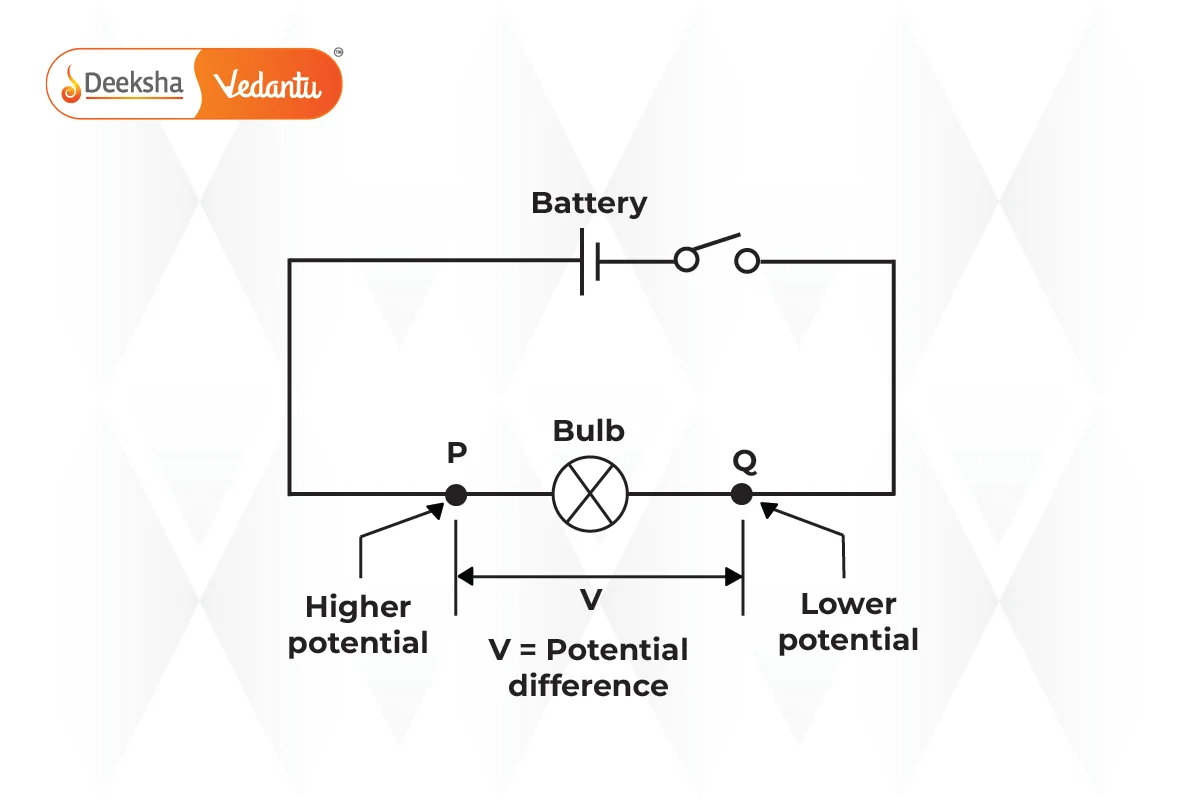Introduction
Electric potential and potential difference are fundamental concepts that help us understand how electric charges behave in an electric field or a circuit. These concepts are crucial for understanding the flow of current in electrical systems, how energy is transferred in circuits, and how electric devices operate. In this detailed guide, we will explore electric potential, potential difference, their physical significance, and their applications in real-world scenarios.
Electric Potential
The concept of electric potential helps us quantify the work done to move an electric charge in an electric field. It is an important parameter that determines the energy a charge has due to its position in the field.
Definition of Electric Potential
Electric potential at a point in an electric field is the amount of work done to move a unit positive charge from a reference point (usually infinity) to that point against the electric force.

- Mathematically, electric potential (
) is given by:
Where:= Electric potential (in volts,
)
= Work done to move the charge (in joules,
)
= Charge (in coulombs,
)
- The SI unit of electric potential is the volt (
). One volt is defined as one joule of work done to move one coulomb of charge from one point to another.
- Electric potential is a scalar quantity, meaning it has magnitude but no direction. It helps us understand the potential energy a charge possesses when placed at a specific point in the electric field.
Physical Meaning of Electric Potential
Electric potential provides us with a way to measure how much work is required to move a charge in the presence of an electric field. Think of it as an analogy to gravitational potential in a gravitational field. Just as it takes work to lift an object against gravity, it takes work to move a charge in an electric field.
- Higher Potential: A point in space where more work is required to bring a positive charge is said to be at a higher potential.
- Lower Potential: A point where less work is needed to move the same charge is at a lower potential.
The difference between these potentials is what drives electric current in a circuit (explained below under potential difference).
Potential Difference
While electric potential describes the energy at a specific point, potential difference (or voltage) explains how much work is done when a charge moves between two points in an electric circuit or field.

Definition of Potential Difference
Potential difference between two points is defined as the amount of work done to move a unit charge from one point to another. It is the driving force that causes electric current to flow in a circuit.
- Mathematically, potential difference (V) between two points A and B is:
Where:
= Potential difference between the points (in volts,
)
= Work done to move the charge (in joules,
)
= Charge moved (in coulombs,
)
is equivalent to 1 joule of work done to move 1 coulomb of charge between two points.
Potential Difference in Circuits
In an electric circuit, the battery or power supply creates a potential difference between its terminals. The positive terminal of the battery is at a higher potential, while the negative terminal is at a lower potential. This potential difference provides the necessary push (or “electromotive force,” emf) that makes electric charges (typically electrons) move through the circuit.
- Potential difference is the cause of the flow of charges (electric current) in a circuit.
- When a circuit is complete (closed), electrons flow from the negative terminal (lower potential) to the positive terminal (higher potential). In the conventional current model, current is said to flow from the positive terminal to the negative terminal.
Example:
If a battery creates a potential difference of 12 V between its terminals, it means that 12 joules of work are done to move 1 coulomb of charge between the positive and negative terminals of the battery.
Measuring Potential Difference
The potential difference between two points in a circuit can be measured using a device called a voltmeter. A voltmeter is always connected in parallel across the component or section of the circuit where the potential difference is to be measured.
- The voltmeter has high internal resistance to ensure that it does not disturb the circuit or draw current from it.
- The unit of potential difference is the volt (V)..
Relationship Between Electric Potential and Electric Potential Energy
The concept of electric potential energy is closely related to electric potential. If we place a charge at a point with electric potential
, the charge will have electric potential energy given by the formula:
Where:
= Electric potential energy (in joules,
)
= Charge (in coulombs,
)
= Electric potential (in volts,
)
Key Concept:
- A charge gains potential energy when moved against the electric field (from lower potential to higher potential).
- A charge loses potential energy when it moves in the direction of the electric field (from higher potential to lower potential).
Example: If we place a charge of 2 C in a region with a potential of 5 V, the electric potential energy of the charge will be:
How Electric Potential and Potential Difference Work in Circuits
In an electric circuit, electric potential and potential difference play critical roles in determining how charges move and how current flows:
- The battery creates a potential difference across its terminals (e.g., 12 V), causing charges to move from the negative terminal (lower potential) to the positive terminal (higher potential).
- As the charges move through the circuit, they lose potential energy when they pass through components like resistors or light bulbs, where this potential energy is converted into other forms of energy (e.g., light, heat).
- In a simple series circuit, all the components share the same current, but the potential difference (voltage) across each component may vary depending on its resistance.
Example:
If you connect a 9 V battery to two resistors in series, the total potential difference across both resistors will be 9 V. However, the voltage drop across each resistor will depend on its resistance.
Electric Potential Difference and Ohm’s Law
Ohm’s Law provides a clear relationship between potential difference, current, and resistance in a circuit:
Where:
Ohm’s Law shows that the potential difference across a component is directly proportional to the current flowing through it, provided the resistance remains constant.
Example:
If a resistor with a resistance of is connected to a battery with a potential difference of 12 V, the current flowing through the resistor can be calculated using Ohm’s Law:
Therefore, the current in the circuit is 3 A.
Practical Real-Life Applications of Potential Difference
Potential difference is crucial in a variety of real-world applications, as it determines how electric current flows and how electrical energy is used:
- Household Appliances:
- Household electrical circuits operate at a fixed potential difference, typically 220 V or 110 V (depending on the country). This potential difference drives the current through appliances like refrigerators, televisions, and washing machines, allowing them to function.
- Electric Vehicles:
- Electric vehicles (EVs) use large batteries that create a potential difference between the terminals. This potential difference drives the current through the motor, converting electrical energy into mechanical energy to move the vehicle.
- Power Generation and Distribution:
- In power plants, generators create a large potential difference (often several thousand volts) to push electric charges through power lines. This electricity is then transmitted over long distances to homes and industries. Transformers adjust the potential difference for safe and efficient delivery.
- Medical Devices:
- Medical equipment like defibrillators use a high potential difference to deliver electric shocks to restore a patient’s heart rhythm. The high voltage allows sufficient current to flow through the patient’s body, restarting the heart.
- Lighting Systems:
- Streetlights and household bulbs rely on potential difference to allow current to flow through the filament or LED, producing light. The brightness of the light depends on the potential difference and the design of the bulb.
Key Practice Questions
Q1: A battery does 36 J of work to move 3 C of charge through a circuit. What is the potential difference across the battery terminals?
- Answer:
Q2: If the potential difference across a resistor is 15 V and a current of 2 A flows through it, what is the resistance of the resistor?
- Answer:
- Using Ohm’s Law:
- Using Ohm’s Law:
Q3: How much work is done to move 6 C of charge through a potential difference of 5 V?
- Answer:
Q4: A voltmeter measures a potential difference of 20 V across a light bulb. If the resistance of the bulb is 10 Ω\OmegaΩ, calculate the current passing through the bulb.
- Answer:
- Using Ohm’s Law:
- Using Ohm’s Law:
FAQs
Ohm’s Law states that the potential difference across a conductor is directly proportional to the current flowing through it, provided the resistance remains constant. Mathematically, .
Electric potential at a point is the potential energy per unit charge at that point. The potential energy of a charge Electric potential at a point is the potential energy per unit charge at that point. The potential energy of a charge qqq at a point with electric potential V is given by . at a point with electric potential V is given by
.
Potential difference represents the energy required to move a unit charge between two points in an electric field or circuit. It is the driving force behind the flow of electric current in a circuit.
Potential difference is measured using a voltmeter. The voltmeter is connected in parallel across the two points between which the potential difference is to be measured.
The SI unit of potential difference is the volt (V).
Related Topics
- Reflection Of Light
- Kirchhoff’s Law
- Defects Of Vision And Their Correction
- Work, Energy and Power
- Refraction Of Light
- Thermodynamics
- Refraction Of Light Through A Prism
- Physics FAQs
- Electricity
- Bernoullis Principle
- Electric Current And Circuit
- Fleming’s Left-Hand Rule and Right-Hand Rule
- Magnetic Field Due To A Current – Carrying Conductor
- Compound Microscope
- Concave Mirrors and Convex Mirrors




![Rendered by QuickLaTeX.com \[\displaystyle\boldsymbol{V = \frac{W}{Q}}\]](https://deekshalearning.com/wp-content/ql-cache/quicklatex.com-d098c0bc5aaab7fb45611fcf89954b63_l3.png)




Get Social